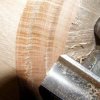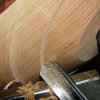XXAMIAM said:
Im new to all this and Now that you guys got me totally confused and scared I dont know what tools i have . So how do i go about identifying my tools ?
If you're scared, make sure it's for the right reason. Nomenclature shouldn't slow you down. There are
forged pattern - uniform thickness - and
ground pattern - flute ground into a cylindrical piece of stock - gouges. From there on out, people have them ground in so many configurations and have so many legends as to completely befuddle, but not scare a thinking man.
My second favorite legend about gouges is that "bowl" gouges are
stronger than "spindle" gouges. One can only speculate as to whether they select inferior steel at the outset, or deliberately weaken them after the flute is ground. There's even more metal on the "spindle" gouge for people who don't know about beam strength.
Look at Russ' five points and stick to them. My notes follow.
1) Remember your force vectors. 90 degrees to the rest is best. Closer you can stay to that while cutting, the less the cut depends on your strength or reaction.
2) More bevel better. Makes a gouge with a large radius more stable. Less likely to catch, because it can't turn if there's no space between bevel and wood. That's a great reason for having the same bevel angle all the way, as forged pattern gouges can have.
3) Of course, there are always rotational forces, that's what a lathe does - rotate wood. The game is to make that steep entry cut where they're greatest with body english, and smoothly transition to a peel. You can take advantage of the rotation in a couple of ways, too. Since the greater diameter moves at a greater speed, it wants to throw a tool outward, which is in the safe direction on convex surfaces. Nice, but you pay the price inside. Second, if you orient the tool as you do your pocket knife when whittling, at a skewed angle, the rotation draws the wood down the edge, helping it cut itself. Best cut is the one which takes least effort by you and the lathe.
4) Second rule of turning is never give leverage to the piece. Keep the rest in tight as you can, and don't hesitate to stop the lathe twenty times to adjust it closer. Remember the first rule as you restart the lathe. That's the one that says stay out of the way of flinging chunks.
5) Of course, all tools have sharp edges, only some have corners. All tools can get caught in tight spots with a moment's inattention. A catch is just a case where you've stabbed, rather than sliced. The less maneuvering room you have, the smaller the tool you should use, though the grind of similar-sized tools may differ enough to allow one to be safely used, where the other would grab and smack you.
Then there are tools which don't work unless you bend rules two and five. They're called scrapers.





